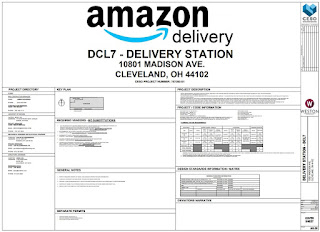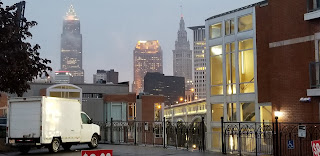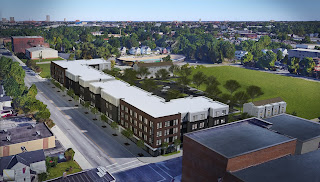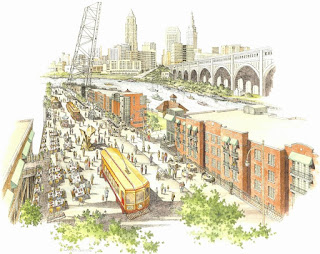And when that university is also trying to reconfigure its athlethic facilities, privatize its parking and capitalize on Cleveland's international standing as a medical center, then it's time to take a fresh look at its campus.
So Cleveland State University (CSU) has issued a request for qualifications from urban planning and design firms to create an updated master plan for what is currently an 85-acre campus. According to the Dodge Reports, CSU is requesting qualifications for planning services to be submitted by 2 p.m. July 24 to Jeremiah Swetel, CSU's executive director of facility services.
The plan is essential for securing funding, be it from public- or private-sector sources, for any capital construction projects at the state university that has 12,248 undergraduates and a total enrollment of 16,327. That's compared to 10,132 undergraduates and 15,293 total enrollment since Fall 2000. CSU President Harlan Sands has called for the master plan as he juggles multiple challenges regarding its facilities.
Because CSU is at the eastern edge of downtown Cleveland, any changes to buildings of 10 stories or more or new buildings of similar size will be noticeable if built in and near CSU. So, for example, if the 21-story, 363-foot-tall Rhodes Tower were to be significantly renovated or even replaced, it would alter the skyline.
Changing or replacing the campus' tallest building, including the library and main classroom building, is reportedly going to be one of the possible projects considered. This connected complex will turn 50 years old next year and is in need of renovations and modernization.
And when CSU completed its last campus master plan in 2014, it had recently made some significant investments in improving its facilities as a residential school. The university converted the 22-story Fenn Tower into a 438-bed residence hall in 2006. Five years later, it traded the 438-bed Viking Hall for the slightly larger and brand-new 600-bed Euclid Commons, 2450 Euclid Ave.
More students continue to come and, increasingly, they are coming from out of state, especially from more expensive East Coast cities and Chicago. The students are seeking a good education in an urban setting but without the burdensome tuition. In August 2017, CSU welcomed its first-ever 2,000-student freshman class.
"This new milestone further highlights the transformation Cleveland State has undergone over the last decade," said then-CSU President Ronald Berkman. "We are now a destination university with a growing national reputation for offering students tremendous academic quality and excellent career connections in a vibrant urban environment."
Part of the answer may lie at the site of the Wolstein Center. This 13,610-seat arena was built in 1991 to serve a fast-growing college basketball program as well as the Cleveland Crunch professional indoor soccer team, concerts and nationally prominent speakers.
But when the Cleveland Cavaliers moved downtown in 1994 to the new and larger Gund Arena (now Rocket Mortgage Fieldhouse) and the Crunch folded, the Wolstein Center never achieved its promise. Today, the Wolstein Center burdens CSU with a $1 million-per-year operating deficit.
Replacing the arena with a smaller facility has been on CSU's to-do list for at least five years. It sits at the center of a 9.3-acre parcel that if, utilized more effectively, could accommodate a smaller arena of about 5,000-7,000 seats surrounded by new student housing. A local model is Case Western Reserve University's outdoor DiSanto Field which is ringed with dorms, bleachers and a parking garage.
CSU athletic facility the master plan will likely take a hard look at is Krenzler Field. The soccer and lacrosse field features a removable, air-supported dome. It neighbors on Chester the Viking Softball Field and the Medical Mututal Tennis Pavilion. Krenzler Field was renovated in 2018 for $2.9 million.
But as lacrosse and especially soccer have increased in popularity, including the possibility of a professional outdoor soccer team playing in Cleveland, the 1,500-seat facility may be too small. A larger stadium could be part of the master plan and incorporate facilities for softball and tennis. The 2014 plan had these athletic facilities moved closer to Interstate 90 but, like the Wolstein Center's replacement, it never happened.
One of the reasons why the athletic facilities sat on the back burner is because the university has been reviewing a new parking privatization plan. It could net CSU more than $50 million up front and possibly hundreds of millions of dollars in the coming decades from investing those funds. CSU has seven parking garages and 16 lots totaling 4,131 parking spaces.
Additional parking and public transportation facilities could be in the offing. Access to CSU on the Greater Cleveland Regional Transit Authority's trains and buses from the eastern suburbs is slow and all routes require at least one transfer to reach CSU. Improved transit circulation downtown would create a more connected neighborhood for CSU's residential students.
loop of downtown Cleveland, according to the nonprofit group All Aboard Ohio.
Last but certainly not least is an exciting new effort to boost CSU as a center of medical innovation. Earlier this year, CSU hired Forrest Faison III, former U.S. Navy Vice Admiral and served as the 38th Surgeon General of the Navy and chief of the Bureau of Medicine and Surgery from 2015 to 2019.
He was named senior vice president for research and innovation/chief healthcare strategy officer at CSU. Faison will oversee a broad effort to unify and expand the university's educational, outreach and scholarship efforts in all aspects of health care, while spurring the continued growth of Cleveland as a center for medical innovation.
“(Faison's) leadership will also be critical to further our efforts to create the health care programs, technologies and workforce that will improve the lives of people throughout the community and enhance the continued advancement of the regional economy,” said CSU President Sands in a written statement.
So CSU joined with NEOMED to create the NEOMED-CSU Partnership for Urban Health, which has its physical presence in the 2015-built, $48 million Center for Innovations in Medical Professions Building at the southwest corner of Euclid Avenue and East 22nd Street.
As a result of Faison's hiring, look for a significant new medical school and research buildings to be included in CSU's upcoming master plan, said one of the two sources. The new medical school and research facilities could feature thousands of students and research jobs and be a magnet for many millions of dollars of state and federal funding for education and research.
CSU's strengthened effort in the healthcare field is intended to provide a steady and voluminous supply of students and interns for Greater Cleveland's large medical institutions. And it will likely strengthen the region's already robust healthcare research scene.
END



































